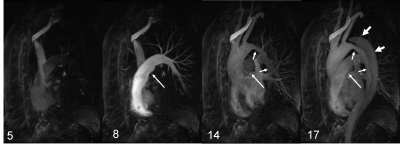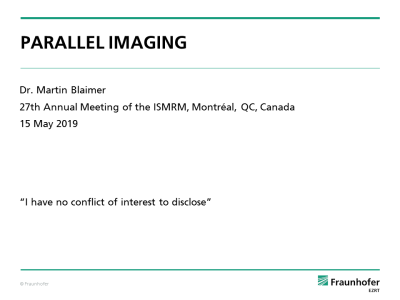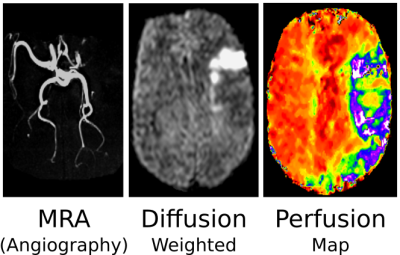MR Physics & Techniques for Clinicians (3)
MR Physics & Techniques for Clinicians
Weekday Course
Weekday Course
ORGANIZERS: Bernd Jung, Marcus Alley, Dong-Hyun Kim
Wednesday, 15 May 2019
| Room 710A | 15:45 - 17:45 | Moderators: Dosik Hwang, Geon-Ho Jahng |
Skill Level: Basic to Intermediate
Session Number: W-01
Overview
This two-hour course will be a basic and comprehensive review of MRI physics and techniques. The presentations will be non-mathematical and suitable for clinicians and physicists new to the field. The course will cover the basic principles of MR physics (signal generation, encoding, and relaxation) and image quality.
Target Audience
This course is primarily designed for the clinician who will benefit from an understanding of the "hows" and "whys" of MR imaging. While it requires no prior experience with MR, those with some familiarity and experience will also benefit. Those interested may include: radiologists and clinicians relatively new to MR imaging (including residents and fellows), experienced radiologists and clinicians wanting a refresher course in MR physics, and physicists and engineers wanting an introduction to the field.
Educational Objectives
As a result of attending this course, participants should be able to:
- Define and describe the fundamental principles of MR imaging including the definition of spin magnetization;
- Explain the Larmor relationship, relaxation phenomena, and the process of using the spin magnetization to produce an image; and
- Describe how changing acquisition parameters impacts on the image quality and understand the parameter relationships.
Overview
This two-hour course will be a basic and comprehensive review of MRI physics and techniques. The presentations will be non-mathematical and suitable for clinicians and physicists new to the field. The course will cover the basic principles of MR physics (signal generation, encoding, and relaxation) and image quality.
Target Audience
This course is primarily designed for the clinician who will benefit from an understanding of the "hows" and "whys" of MR imaging. While it requires no prior experience with MR, those with some familiarity and experience will also benefit. Those interested may include: radiologists and clinicians relatively new to MR imaging (including residents and fellows), experienced radiologists and clinicians wanting a refresher course in MR physics, and physicists and engineers wanting an introduction to the field.
Educational Objectives
As a result of attending this course, participants should be able to:
- Define and describe the fundamental principles of MR imaging including the definition of spin magnetization;
- Explain the Larmor relationship, relaxation phenomena, and the process of using the spin magnetization to produce an image; and
- Describe how changing acquisition parameters impacts on the image quality and understand the parameter relationships.
| 15:45 |
 |
MR Angiography
Oliver Wieben
Traditional clinical MR Angiography (MRA) provides volumetric datasets to characterize the vessel lumen. These MRA techniques can be generally separated into two categories: contrast-enhanced MRA, which requires the venous injection of a paramagnetic contrast agent in form of a Gadolinium (Gd) chelate and non-contrast-enhanced MRA (NCE MRA), which relies on signal properties of the blood or the motion of the blood to create signal differences between the blood pool and the surrounding tissues. The underlying contrast mechanisms of contrast-enhanced (CE MRA), time-of-flight, phase-contrast, and balanced steady state free precession (bSSFP) MRA will be discussed including recent developments in accelerated dynamic contrast-enhanced MRA (CE-MRA), the use of iron-based contrast agents, and velocity-encoded MRI.
|
| 16:25 |
 |
Parallel Imaging
Martin Blaimer
In recent years, parallel imaging techniques have become essential tools for accelerating MRI exams. Nowadays, basically all modern MR systems are equipped with multi-channel coil arrays and dedicated reconstruction algorithms. After a short historical overview, this talk will describe the basic concepts of parallel imaging. Limitations due to noise amplification (i.e. g-factor) and reconstruction artifacts will be discussed and applications will be presented. Finally, future perspectives (e.g. extensions with compressed sensing or machine learning) will be outlined.
|
| 17:05 |
 |
Diffusion & Perfusion Weighted Imaging
Matthias Weigel
This lecture will explain the two important and popular imaging concepts of “diffusion weighted imaging (DWI)” and “perfusion weighted imaging (PWI)”. The underlying physics and fundamental properties will be explained in a pictorial way (with only a few easy mathematical equations that may be important to recognize or use). The clinical significance and potentials of the two methods are also discussed. At last, DWI and PWI are combined to establish the so-called “diffusion-perfusion-mismatch-concept” in (acute) ischemic stroke.
|
| 17:45 |
Adjournment |
 Back to Program-at-a-Glance |
Back to Program-at-a-Glance |  Back to Top
Back to Top